RNCM: José del Avellanal - 'three breaths (after Ben)'
[This is the first in a series of blog posts by project participants on their work. José is a 4th year undergraduate student at the RNCM]
* * * * *

José Del Avellanal
I became involved in the RNCM strand of The Garden of Forking Paths in early 2020, and after a period of indecision about how to best approach my contribution to the project, I started making progress in April. The main catalyst for this was the release of a lockdown call for ‘multiphonic miniatures’ by Heather Roche and Scott McLaughlin, which offered composers the opportunity to develop small-scale works – under 2 minutes – focused on the exploration of clarinet multiphonics. These little experiments would then be tried out by Heather and composers would receive a recording of it along with some feedback.
The peculiarity of these multiphonic miniatures is that they featured a really interesting set of rules, such as the obligation to explore multiphonics dynamically – as opposed to static blocks of sound – and to choose an area of focus from a set of possible limitations. I personally thought these rules were fantastic, as they helped me understand the aims of the project better and forced me to approach my own research in a really focused way, which definitely made the first steps a lot easier. I was really intrigued by one of the suggested limitations, ‘extreme stability’, and I wondered if it would be possible to use stability to access new, unexpected outcomes.
With this in mind, I did some research through Heather’s blog, and noticed how there were some cases of stable multiphonics with very similar fingerings. I compiled all I could find and tested them with clarinettists Ben Pinto and Oliver Lee (my RNCM project partners) and ended up with four similar fingerings which became the basis for my first multiphonic miniature, seven breaths.
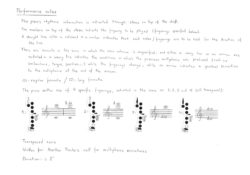
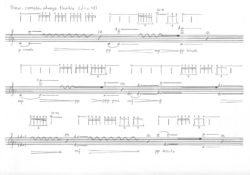

The idea behind seven breaths was to explore the transition between fingerings which, in isolation, produce stable multiphonics, with the intention to create situations which may give place to new sonic results. The piece, while pretty, did not really succeed in this aspect, it felt and sounded too safe. Further conversations with Scott helped me understand why my approach did not work as intended – simply put, the fingerings were too similar for the loading and venting that resulted of the different transitions to generate significant change – and offered me really valuable thoughts on how to take my ideas further. Instead of focusing on the transition between fixed fingerings, Scott suggested a more exhaustive approach, focused on one fingering only and the exploration of its different loading and venting possibilities, and I decided to write a new miniature incorporating those ideas.
I chose one of my multiphonics from seven breaths – one which involved all nine fingers and 10 keys – and proceeded to break down all the different fingering variations which resulted from lifting one or two keys or holes from the original fingering. The result was a rather intimidating list of 63 options, which I sent to Oliver and Ben to try out, like in our previous test, the transition from the original multiphonic to each of the new fingerings. Since there was so many of them to go through, Oliver did the odd fingerings and Ben did the even ones.


This whole testing process had to be developed long-distance from our own homes, since lockdown measures were in place. Our way of working consisted in me sending a document with material to be tested and some instructions, and they would in their own time send me audio recordings of themselves trying these out. This method, while initially chosen for its flexibility, also implied that during the testing process there would not be any interference between myself and the clarinettists, or even between the clarinettists themselves. As a consequence of this, and possibly some vagueness in my development of the instructions, Ben’s and Oliver’s approaches turned out to be quite different.
Both of them used a consistent different multiphonic from each other as their starting point, as Ben would overblow to a higher partial than Oliver. Their use of dynamics was really different as well – Oliver's being significantly louder – and also Oliver's approach consisted on going back and forth between the given fingerings while Ben's pacing was much slower and instead focused on the transition from the initial fingering to the new one. Here are samples from Ben and Oliver (respectively).
These differences ensured very different sonic results from both of them and, as a result, I decided to develop two distinctive miniatures, one after each player. Combining my practical knowledge from the testing with the clarinettists alongside technical concepts acquired through my research – my most important sources being Heather Roche’s blog, Scott McLaughlin’s YouTube content and Jack Yi Jing Liang’s 2018 DMA Thesis – two new miniatures saw the light – three breaths (after Oliver) and three breaths (after Ben).
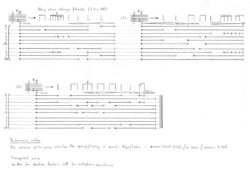
three breaths (after Ben)

three breaths (after Oliver)
I was really lucky that three breaths (after Ben) was brought forward for an online workshop with Heather and Scott as part of The Garden of Forking Paths presentation at the RMA Annual Conference in September. This was a wonderful opportunity that offered me really insightful feedback on the piece, as well as some critical thought into its less successful areas. From a sonic perspective, this new approach was undoubtedly more successful than my first miniature – the less rigid approach to the multiphonics allowed for very interesting and, I believe, quite beautiful and exciting outcomes. Heather and Scott offered some very interesting suggestions regarding dynamics and different ways to orientate the player towards specific playing situations, since elements like articulation, embouchure and area of focus of multiphonic production were very open fields in the piece.
However, there was also a lot of discussion around notation, which was by far the most problematic issue of the piece. It was difficult for Heather to navigate her way through the score due to how spread out the notation for the movement of each finger was, as well as the lack of clear points of reference. Overall, there was a shared opinion between both of them that there was too much information on the page, and that the notational system could be simplified and condensed much further.
Taking in their feedback and suggestions, I recently developed three new versions of the piece, with very different approaches to notation.
I am very interested in hearing different clarinettists’ opinions on which of them works better, and using this new acquired knowledge for the development of a future miniature which pushes these ideas even further. I hope to be able to offer an update in not too long!
[Listen to José's piece played by Heather Roche here]

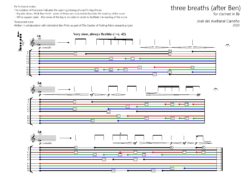
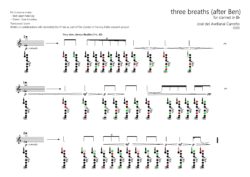
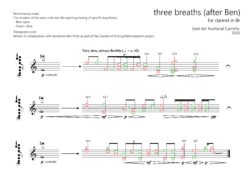
BIBLIOGRAPHY
Liang, Jack Yi Jing, ‘Clarinet Multiphonics: A Catalog and Analysis of Their Production Strategies’, DMA Thesis, University of Arizona, 2018
McLaughlin, Scott, and Roche, Heather, Multiphonic Miniatures, [accessed 10 April 2020]
McLaughlin, Scott, ‘Garden of Forking Paths’ YouTube, [accessed 9 August 2020]
Roche, Heather, Heather Roche | Clarinettist, [accessed 27 June 2020]
